Sony Bundle
Can Sony's "Creative Entertainment Vision" Propel It to New Heights?
Sony, a titan in the global market, has masterfully transformed itself, focusing on entertainment, content, and creation. This strategic shift is the cornerstone of its long-term vision, designed to deliver 'Kando' through innovation and technology. From its origins in post-war Japan, Sony has evolved into a powerhouse, constantly pushing boundaries and redefining consumer experiences.
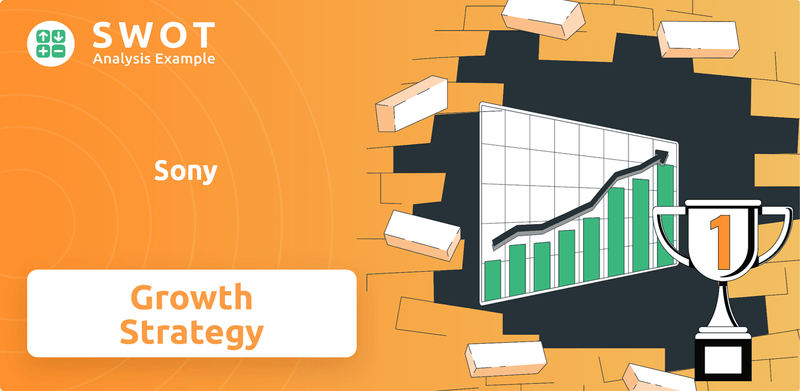
This deep dive into Sony SWOT Analysis will explore the company's ambitious Sony growth strategy. We'll examine Sony's future prospects, analyzing its business model, market share, and the competitive landscape. Furthermore, we'll uncover Sony company analysis, including its expansion plans, financial performance, and the long-term vision for its diverse divisions, offering actionable insights for investors and strategists alike.
How Is Sony Expanding Its Reach?
The Sony growth strategy focuses on reinforcing its core entertainment businesses, increasing market share, and exploring new growth areas. This approach is evident across its gaming, music, pictures, and electronics divisions. A comprehensive Sony company analysis shows a strategic shift towards content creation and expansion in emerging markets, aiming to capitalize on digital streaming and location-based entertainment.
The company's Sony future prospects are closely tied to its ability to innovate and adapt within a competitive landscape. Sony is investing in its intellectual property (IP) to maximize value across its entertainment sectors. This includes strategic acquisitions and partnerships, such as the alliance with KADOKAWA CORPORATION, to strengthen its position in the market.
Sony's expansion initiatives are designed to drive revenue growth and enhance its market position. The company is leveraging its established brands and technologies to create new revenue streams. This strategy is supported by investments in content creation, strategic partnerships, and the expansion of its digital presence.
In the gaming sector, Sony plans to increase the installed base of PlayStation consoles and enhance gaming experiences. The company is also diversifying into PCs and improving first-party software titles. Starting in fiscal year 2025, Sony intends to release major single-player game titles annually, beginning with 'Ghost of Yotei,' the sequel to 'Ghost of Tsushima.'
The music division is gaining momentum from digital streaming, with anticipated higher sales in each quarter of 2025. This is driven by soaring revenues from live events, merchandising, and licensing. Sony is also investing in evergreen music catalogs, which provide stable, long-term earnings from streaming and media use.
For the Pictures segment, Sony expects TV and streaming licensing revenues to improve from the second half of fiscal year 2025. Major film releases like 'Bad Boys: Ride or Die' and 'Venom: The Last Dance' are expected to contribute to this growth. Sony is also expanding its reach in anime, building on the success of Aniplex and Crunchyroll.
In its Electronics Products & Solutions (EP&S) segment, Sony is shifting its focus towards content creation products and services. This includes new camera launches such as the Bravia 3, Bravia 5, and Bravia 8 II TVs in 2025. The company is also strengthening its sports data-related capabilities, exemplified by the acquisition of KinaTrax in October 2024.
Sony's strategic initiatives are designed to capitalize on market trends and strengthen its competitive position. The company's focus on content creation, strategic partnerships, and expansion into new markets reflects its long-term vision. The Sony business model is evolving to incorporate digital streaming, content licensing, and location-based entertainment to drive growth. For more details on their marketing approach, see the Marketing Strategy of Sony.
Sony's expansion plans include a focus on gaming, music, pictures, and electronics. These initiatives are supported by strategic acquisitions, partnerships, and investments in content creation. The company is also exploring new revenue streams through digital platforms and location-based entertainment.
- Annual release of major single-player game titles.
- Investment in evergreen music catalogs.
- Expansion of anime content through Crunchyroll.
- Focus on content creation products in the EP&S segment.
Sony SWOT Analysis
- Complete SWOT Breakdown
- Fully Customizable
- Editable in Excel & Word
- Professional Formatting
- Investor-Ready Format
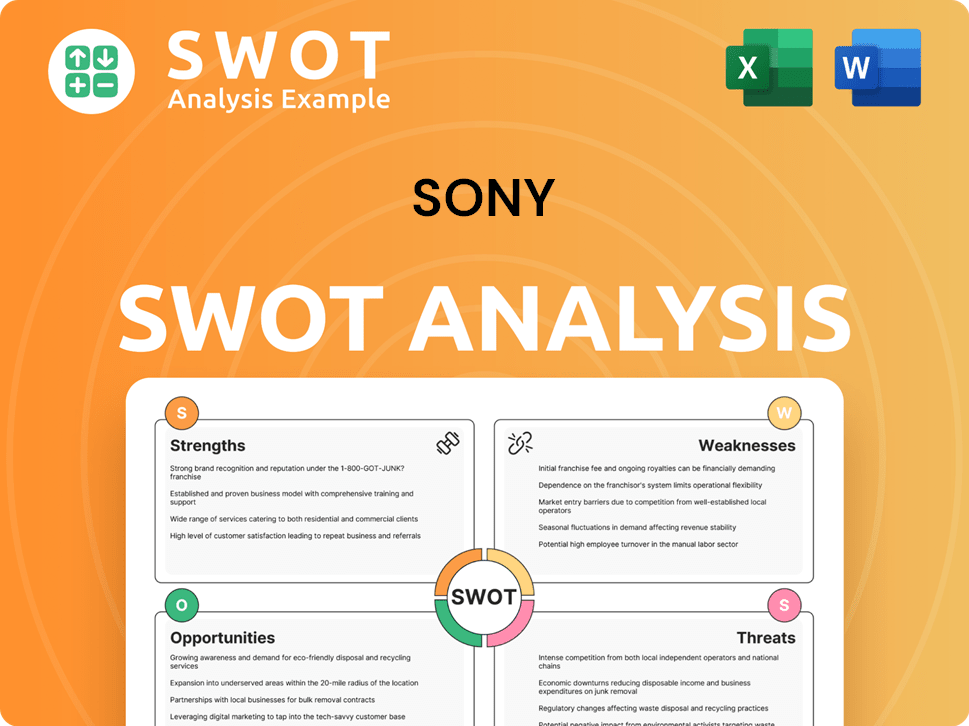
How Does Sony Invest in Innovation?
Understanding the innovation and technology strategy is crucial when conducting a comprehensive Sony company analysis. This strategy is deeply embedded within its 'Creative Entertainment Vision,' focusing on leveraging cutting-edge technologies to enhance existing products and explore new frontiers. The company's approach to technology directly impacts its Sony future prospects and its ability to maintain a strong position in a competitive market.
Sony's growth strategy hinges on significant investments in research and development (R&D), particularly in its Gaming & Network Services (GN&S) and Imaging & Sensing Solutions (I&SS) segments. These investments are designed to drive innovation and create a competitive edge in the consumer electronics market. The company's commitment to technological advancements is a key factor in its long-term vision for its various divisions.
The company's commitment to technological advancements is a key factor in its long-term vision for its various divisions. The company is making significant R&D investments, particularly in its Gaming & Network Services (GN&S) and Imaging & Sensing Solutions (I&SS) segments. These investments are designed to drive innovation and create a competitive edge in the consumer electronics market. For more insights into its consumer base, consider reading about the Target Market of Sony.
Sony's gaming segment is a major focus for R&D investment. For the fiscal year ending March 31, 2024, approximately 300 billion yen (about $2.17 billion) was allocated to R&D in this segment. This figure represents about 40% of Sony's total R&D spending.
A significant portion of the gaming R&D is dedicated to live service games. For the fiscal year ending March 31, 2024, 55% of the gaming R&D was allocated to live service games, with an expected 60% for fiscal year 2025. Sony aims to release 12 live service games by the fiscal year ending March 2026.
The I&SS division received approximately $1.48 billion in R&D investment in FY2024. This investment underscores the importance of sensor innovation. The company aims to achieve further growth in the mobile image sensor business by capitalizing on the trend toward larger sensor sizes.
Sony is actively pursuing innovation in content creation technology. This includes developments like 'XYN,' real-time VFX, and 360 Virtual Mixing Environment. These technologies enhance the capabilities of content creators and contribute to Sony's position in the entertainment industry.
Sony is developing a new engagement platform leveraging PlayStation Network's core backend functions. This platform aims to enhance monetization and allow group companies to focus resources on improving competitiveness and differentiation. This strategy is crucial for Sony's business model.
Sony is embracing digital transformation and the use of cutting-edge technologies like AI, IoT, and sustainability initiatives. AI plays a dual role in content creation, generating personalized content and optimizing distribution strategies. The company is also investing in 5G technology and expanding its VR and AR capabilities.
Sustainability is a key driving principle for Sony. The company's 'Road to Zero' plan aims to achieve a zero environmental footprint by 2040. Under its 'Green Management 2025' program, Sony focuses on eco-friendly manufacturing processes and reducing plastic use.
- By 2030, Sony aims to use 100% renewable energy for electricity at its business sites.
- The company aims to achieve net-zero direct and indirect greenhouse gas (GHG) emissions (scopes 1 and 2).
- Sony plans to reduce scope 3 GHG emissions during product use by 45% by 2035.
- These sustainability efforts are part of Sony's approach to corporate social responsibility.
Sony PESTLE Analysis
- Covers All 6 PESTLE Categories
- No Research Needed – Save Hours of Work
- Built by Experts, Trusted by Consultants
- Instant Download, Ready to Use
- 100% Editable, Fully Customizable
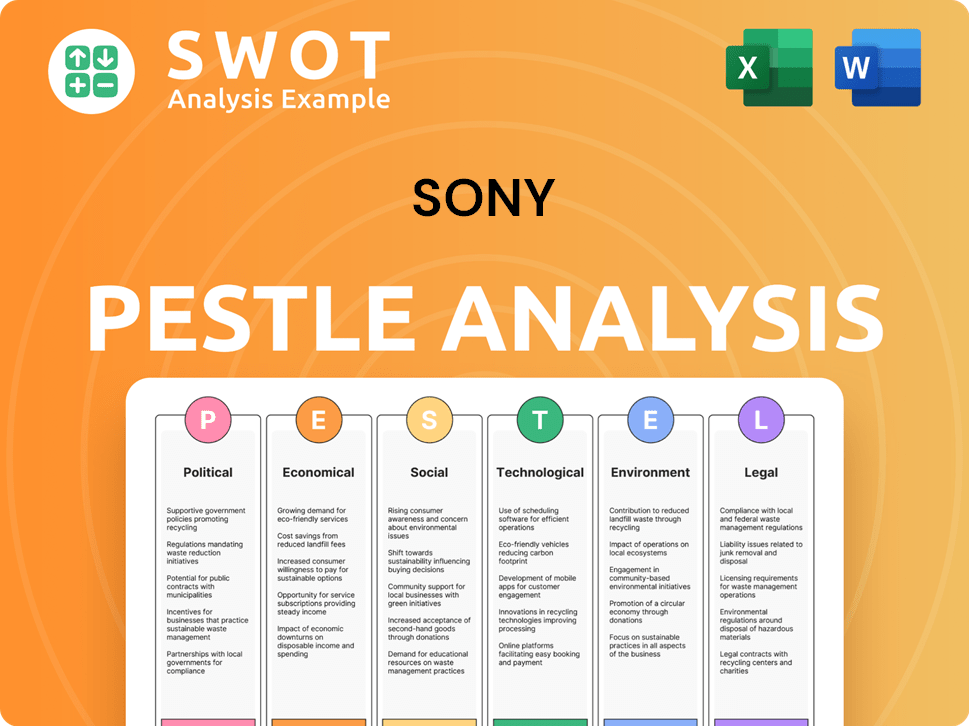
What Is Sony’s Growth Forecast?
The financial outlook for Sony Group Corporation indicates stability and growth across key segments. For the fiscal year ending March 31, 2025, the company anticipates continued positive performance. This assessment is based on a robust financial foundation and strategic initiatives.
Consolidated revenue for FY2024 was approximately $85.2 billion, remaining relatively flat year-over-year. However, operating income saw a significant increase, reaching $9.25 billion, a 16% rise. This demonstrates Sony's ability to navigate market challenges and capitalize on opportunities within its diverse business portfolio. The Sony growth strategy focuses on expanding its profitable sectors.
The Sony company analysis reveals a strategic focus on key growth areas. The Game & Network Services (GN&S) segment is expected to perform well. The Music division is also experiencing healthy momentum. The Imaging & Sensing Solutions (I&SS) division is also contributing significantly. These positive trends support the company's overall financial outlook.
Sony has raised its growth target for the Game & Network Services segment. Revenue is projected to reach ¥4,490 billion, up from the previous estimate of ¥4,320 billion. This increase is partly due to favorable foreign exchange rates, and the PlayStation 5 (PS5) continues to be a key profit driver.
The Music division is experiencing strong growth, driven by live events, merchandising, and licensing in Recorded Music. Streaming revenues in both Recorded Music and Music Publishing are also increasing. Higher sales are anticipated in each quarter of 2025, contributing to the overall positive financial outlook.
The Pictures segment anticipates improved TV and streaming licensing revenues from the second half of fiscal year 2025. This strategic move is expected to enhance the segment's financial performance. This is part of Sony's strategies for content creation and distribution.
The Imaging & Sensing Solutions (I&SS) division reported $11.80 billion in sales for the full fiscal year, a 12% increase. Operating income reached $1.79 billion, up 35% year-over-year. This growth is primarily driven by strong demand for image sensors in smartphones, demonstrating Sony's innovation in entertainment technology.
Analyst forecasts provide further insights into Sony's financial trajectory. Projections indicate earnings and revenue growth of 2.5% and 0.3% per annum, respectively. Earnings per share (EPS) is expected to grow by 3.1% per annum. The return on equity is forecast to be 12.3% in three years. The Sony business model is designed to withstand market fluctuations.
As of April 7, 2025, analyst ratings for SONY stock indicate a bullish consensus. The median price target is $28.75, which implies an 8.9% upside from the current trading price of $26.39. This positive sentiment reflects confidence in the company's future prospects. You can read more about the company's performance in this article about the company's financial health.
Sony maintains a significant Sony market share in several key sectors, including gaming, music, and image sensors. The company's strategic investments and product innovations support its competitive position. The Sony competitive landscape is dynamic and requires continuous adaptation.
Sony's expansion plans include strengthening its presence in the gaming industry. The focus on the PlayStation 5 and network services is a key element of this strategy. The Sony's expansion plans in the gaming industry are ambitious.
The Future of Sony's PlayStation console remains strong, with continued innovation and content development. The company is committed to providing immersive gaming experiences. The PS5 is a key driver of revenue and profit.
While not explicitly mentioned in the provided text, Sony's potential for the electric vehicle market is an area of interest. The company's sensor technology could play a significant role in this sector. Sony's strategy for the electric vehicle market could be a future growth driver.
Sony's long-term vision encompasses innovation across its various divisions. This includes investments in artificial intelligence, content creation, and sustainability. Sony's long-term vision for its various divisions is focused on creating value.
Sony Business Model Canvas
- Complete 9-Block Business Model Canvas
- Effortlessly Communicate Your Business Strategy
- Investor-Ready BMC Format
- 100% Editable and Customizable
- Clear and Structured Layout
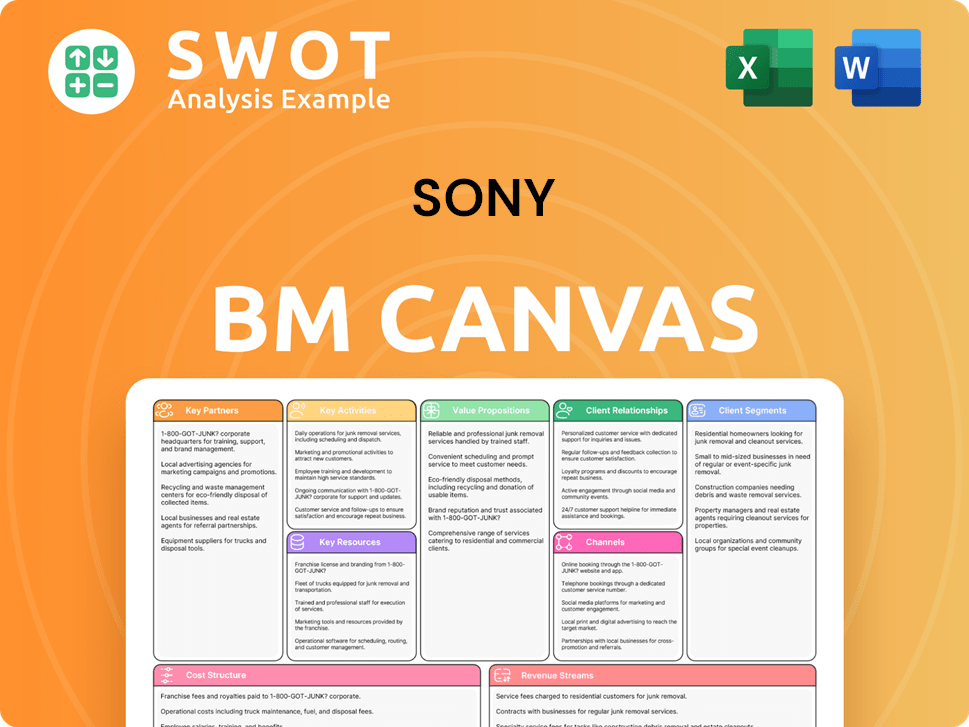
What Risks Could Slow Sony’s Growth?
The path to growth for Sony is fraught with potential pitfalls and obstacles. Understanding these risks is crucial for assessing the company's future prospects and making informed decisions. A thorough Sony company analysis must consider these challenges to provide a complete picture of its strategic landscape.
One of the most significant hurdles facing Sony is the intense competition across its diverse business segments. From consumer electronics to gaming and entertainment, the company battles with established giants and emerging players. This competitive pressure can impact market share and profitability, making sustained growth a complex endeavor.
Furthermore, external factors such as supply chain vulnerabilities, technological disruptions, and regulatory changes pose considerable risks. These elements require proactive management and strategic agility to mitigate their potential impact on Sony's operations and financial performance. The company's ability to navigate these challenges will be critical in determining its long-term success.
Sony faces stiff competition in the consumer electronics market from Samsung, LG, and others. In the gaming sector, the PlayStation competes with Xbox, Nintendo, and the rapidly growing mobile gaming market. The Brief History of Sony provides context on its evolution within this competitive environment.
Sony's reliance on key suppliers for semiconductors and display panels creates supply chain risks. In 2024, procurement costs for semiconductors were at $4.2 billion, and display panel expenditure was $3.7 billion. The concentration of critical component sourcing at 78.6% heightens the risk of disruptions.
Rapid technological advancements require continuous innovation and adaptation. Sony's investments in AI, VR, and new display technologies are substantial, but maintaining leadership is an ongoing challenge. The planned spinoff of the semiconductor division by 2025 could have both benefits and risks.
Changes in regulations and U.S. tariff policies introduce uncertainty. The full impact of tariff adjustments announced in early April 2025, and the partial suspension of China-related tariffs on May 12, 2025, are not yet fully incorporated into Sony's FY2025 earnings forecast.
The mobile gaming market, with platforms like the Apple App Store and Google Play Store, generated $33 billion in revenue in 2023. This poses a direct competitive threat to PlayStation. The mobile gaming market's growth continues to challenge traditional gaming platforms.
The planned spinoff of Sony's semiconductor division could expose the company to greater volatility. This division contributed 16% of total revenue and 18% of operating income in the first nine months of the 2024 fiscal year. While profit margins have decreased from 20% in 2019, the spinoff could affect Sony's financial stability.
Sony manages these risks through diversification, strategic partnerships, and continuous innovation. The company’s 'Road to Zero' environmental plan and 'Green Management 2025' program address sustainability risks. Sony leverages its brand recognition and innovation to differentiate itself and build customer loyalty. These strategies are essential for navigating the competitive landscape and ensuring long-term growth.
Sony operates in a highly competitive market environment. The consumer electronics market sees competition from major players like Samsung and LG. In gaming, PlayStation faces strong rivals in Xbox and Nintendo, as well as the rising influence of mobile gaming platforms. Understanding the competitive landscape is critical for evaluating Sony's future prospects.
Sony Porter's Five Forces Analysis
- Covers All 5 Competitive Forces in Detail
- Structured for Consultants, Students, and Founders
- 100% Editable in Microsoft Word & Excel
- Instant Digital Download – Use Immediately
- Compatible with Mac & PC – Fully Unlocked
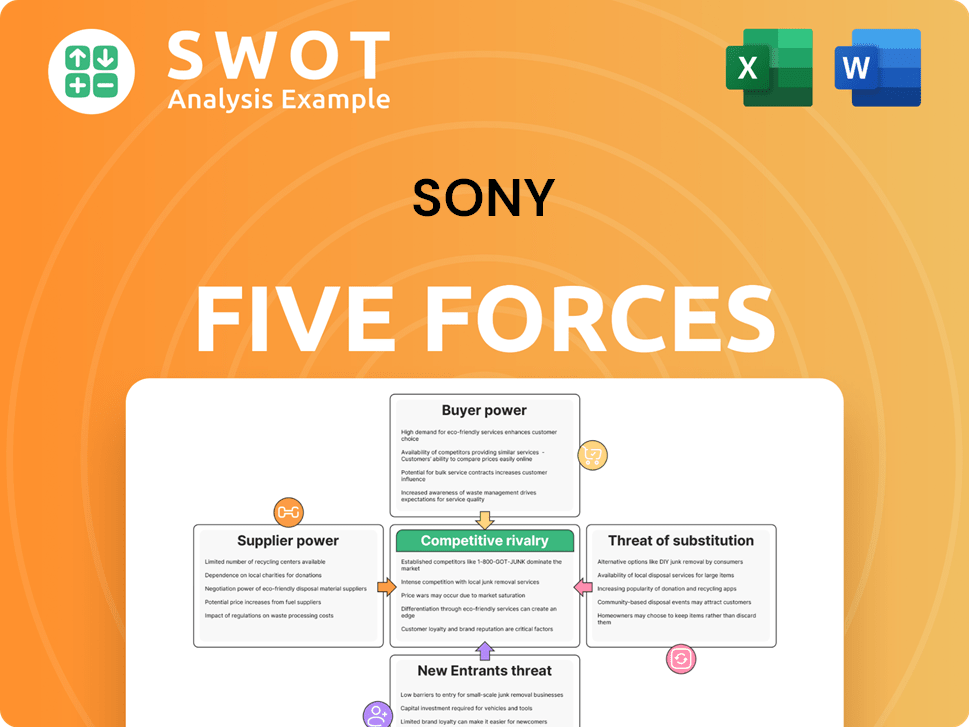
Related Blogs
- What are Mission Vision & Core Values of Sony Company?
- What is Competitive Landscape of Sony Company?
- How Does Sony Company Work?
- What is Sales and Marketing Strategy of Sony Company?
- What is Brief History of Sony Company?
- Who Owns Sony Company?
- What is Customer Demographics and Target Market of Sony Company?
Disclaimer
All information, articles, and product details provided on this website are for general informational and educational purposes only. We do not claim any ownership over, nor do we intend to infringe upon, any trademarks, copyrights, logos, brand names, or other intellectual property mentioned or depicted on this site. Such intellectual property remains the property of its respective owners, and any references here are made solely for identification or informational purposes, without implying any affiliation, endorsement, or partnership.
We make no representations or warranties, express or implied, regarding the accuracy, completeness, or suitability of any content or products presented. Nothing on this website should be construed as legal, tax, investment, financial, medical, or other professional advice. In addition, no part of this site—including articles or product references—constitutes a solicitation, recommendation, endorsement, advertisement, or offer to buy or sell any securities, franchises, or other financial instruments, particularly in jurisdictions where such activity would be unlawful.
All content is of a general nature and may not address the specific circumstances of any individual or entity. It is not a substitute for professional advice or services. Any actions you take based on the information provided here are strictly at your own risk. You accept full responsibility for any decisions or outcomes arising from your use of this website and agree to release us from any liability in connection with your use of, or reliance upon, the content or products found herein.